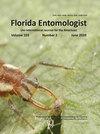大规模诱捕果蝇的食物引诱剂(直翅目:地蝇科)及其对有益节肢动物的选择性
IF 1.2
4区 农林科学
Q3 ENTOMOLOGY
引用次数: 2
摘要
乌拉圭的果蝇控制主要基于不足以减少这些害虫造成的损害的毒饵。因此,大规模诱捕等替代管理措施与飞行控制有关。商业上可用的引诱剂主要用于头虱(Wiedemann)(双翅目:蝙蝠科)。然而,它们也应该对我们水果园中的Anastrepha fraterculus(Wiedemann)(双翅目:铁杉科)有吸引力。这项研究的目的是评估以食物为基础的引诱剂在捕获C.capitata和A.fraterculus性早熟女性方面的有效性,以及它们对有益节肢动物(雏鸟、掠食者和寄生虫)种群的选择性。在2个季节的3种商业水果作物中评估了7种景点;4种商业引诱剂(水解蛋白、液体三甲胺、三甲胺扩散卡和乙酸铵+腐胺扩散卡),20%天然Acca Sellowiana(O.Berg)O.Berg(桃金娘科)果汁,6%蔗糖Molasses和Torula Yeast。这些景点被放置在Mcphail陷阱中,每个星期都会对其进行检查,所有捕获的节肢动物都被移除、计数和分类。捕获的雌性幼崽被解剖以确定鸡蛋的存在。所有被评估的商业景点都有效地捕捉了C.在这两个季节评估的3种水果作物中的头状体。水解蛋白质、液体三甲胺和三甲胺扩散卡对捕获两种物种的年轻雌性都有效。大多数捕获物是收获后的,因此我们建议不要在商业收获后移动陷阱。这些景点也是有选择性的,捕获了少数有益的节肢动物。甘蔗糖霜和菠萝瓜汁对捕捉果蝇雌性无效。摘要乌拉圭果蝇的控制主要基于使用有毒诱饵,这些诱饵已被证明不足以减少其危害。因此,大规模作弊等替代控制策略变得更加重要。商业上可用的引诱剂是为首都角膜炎(Wiedemann)设计的(双翅目:角膜炎科)。然而,在我们的水果作物中,它们也应该对Anastrepha fraterculus(Wiedemann)有效(双翅目:Tephritidae)。这项工作的目的是评估不同食物引诱剂在捕获性发育不成熟的雌性C.capitata和A.fraterculus方面的效率,以及它们对有益节肢动物种群的选择性。在两个季节对三种商品水果作物进行了7种不同的引诱剂的评价;四种商业引诱剂(水解蛋白、液体三甲基胺、扩散卡三甲基胺和醋酸铵+腐胺)、20%的天然Acca Sellowiana汁(O.Berg)或20%的Berg汁(桃金娘科)、6%的甘蔗糖蜜和Torula酵母。引诱剂被放置在McPhail陷阱中,每周对这些陷阱进行审查,所有捕获的节肢动物都被移除、计数和分类。捕获的雌性特弗里德鱼被设计成确定鸡蛋的存在。评估的商业引诱剂在捕获三种评估的水果作物和两个季节的年轻雌性冠状病毒方面都是有效的。水解蛋白、液体三甲胺和三甲胺扩散卡对捕获两个物种的年轻雌性都有效。大多数渔获量是在收获后时期捕获的,因此我们建议在商业收获后不要将大型陷阱从桌子上移开。这些引诱剂也非常有选择性,捕获了很少有益的节肢动物。甘蔗糖蜜和番石榴汁对捕获雌性特弗里特人无效。本文章由计算机程序翻译,如有差异,请以英文原文为准。
Food Attractants for Mass Trapping of Fruit Flies (Diptera: Tephritidae) and Its Selectivity for Beneficial Arthropods
Abstract Fruit fly control in Uruguay is based mainly on toxic baits which are insufficient to reduce the damage caused by these pests. Therefore, alternative management measures such as mass trapping gain relevance for control of flies. Attractants commercially available were designed mainly for Ceratitis capitata (Wiedemann) (Diptera: Tephritidae). However, they also should be attractive to Anastrepha fraterculus (Wiedemann) (Diptera: Tephritidae) in our fruit orchards. The aim of this research was to evaluate the effectiveness of food-based attractants for the capture of sexually immature females of C. capitata and A. fraterculus, as well as their selectivity on the populations of beneficial arthropods (pollinators, predators, and parasitoids). Seven attractants were evaluated in 3 commercial fruit crops during 2 seasons; 4 commercial attractants (hydrolyzed protein, liquid trimethylamine, trimethylamine diffuser card, and ammonium acetate + putrescine diffuser card), 20% natural Acca sellowiana (O. Berg) O. Berg (Myrtaceae) juice, 6% sugarcane molasses, and Torula yeast. The attractants were placed in McPhail traps, which were checked each wk and all captured arthropods were removed, counted, and classified. Captured female tephritids were dissected to determine the presence of eggs. All commercial attractants evaluated were effective at capturing sexually immature females of C. capitata in the 3 fruit crops evaluated during both seasons. Hydrolyzed protein, liquid trimethylamine, and trimethylamine diffuser card were effective at capturing young females of both species. Most of the captures are post-harvest, so we suggest not moving traps after commercial harvest. These attractants also were selective, capturing few beneficial arthropods. Sugarcane molasses and pineapple guava juice were not effective at capturing fruit fly females. Resumen El control de las moscas de la fruta en Uruguay se basa principalmente en el uso de cebos tóxicos, los cuales han mostrado ser insuficientes para reducir sus daños. Debido a esto, estrategias de control alternativas como el trampeo masivo han tomado mayor relevancia. Los atrayentes disponibles comercialmente fueron diseñados para Ceratitis capitata (Wiedemann) (Diptera: Tephritidae). Sin embargo, en nuestros cultivos frutales también deberían ser efectivos para Anastrepha fraterculus (Wiedemann) (Diptera: Tephritidae). El objetivo del presente trabajo fue evaluar la eficiencia de diferentes atrayentes alimenticios en la captura de hembras sexualmente inmaduras de C. capitata y A. fraterculus, y su selectividad respecto a las poblaciones de artrópodos benéficos. Siete atrayentes diferentes fueron evaluados en tres cultivos frutícolas comerciales en dos temporadas; cuatro atrayentes comerciales (proteína hidrolizada, trimethylamine líquido, trimethylamine tarjeta difusora, y acetato de amonio + putrescina), jugo natural de Acca sellowiana (O. Berg) O. Berg (Myrtaceae) al 20%, melaza de caña al 6% y levadura Torula. Los atrayentes se colocaron en trampas McPhail, las que se revisaron semanalmente y todos los artrópodos capturados fueron retirados, contados y clasificados. Las hembras de tefrítidos capturadas fueron disecadas para determinar la presencia de huevos. Los atrayentes comerciales evaluados fueron eficaces en la captura de hembras jóvenes de C. capitata en los tres cultivos frutales evaluados y ambas temporadas. La proteína hidrolizada, el trimethylamine líquido, y la trimethylamine tarjeta difusora fueron efectivos en la captura de hembras jóvenes de ambas especies. La mayoría de las capturas se dieron en el período poscosecha, por lo que sugerimos que las trampas de trampeo masivo no se muevan de los cuadros luego de la cosecha comercial. Estos atrayentes fueron además muy selectivos, capturando pocos artrópodos benéficos. La melaza de caña y el jugo de guayabo no fueron eficaces en la captura de hembras de tefrítidos.
求助全文
通过发布文献求助,成功后即可免费获取论文全文。
去求助
来源期刊

Florida Entomologist
生物-昆虫学
CiteScore
2.10
自引率
7.10%
发文量
44
审稿时长
3 months
期刊介绍:
Florida Entomologist is the official journal of the Florida Entomological Society. Volumes 1-3 were published under the name The Florida Buggist. The Florida Entomological Society still produces the traditionally printed version of Florida Entomologist, but you can also view, search, or print any article published since June 1917 by accessing online files. Web access is made possible by the Society’s electronic publication project begun in 1993
 求助内容:
求助内容: 应助结果提醒方式:
应助结果提醒方式:


